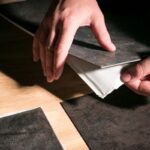Strangely, despite the fact that the Australian colonial period spanned from 1788 through 1901, the most iconic colonial style (especially for dancing), patterns of fashion is the 1850s or 1860s. I didn’t have the time or the patience to make any hoop, so I ventured into the late 1840s.
Since the 1840s skirts were gradually growing in size thanks to several petticoats. Sometimes they were corded to make them stand out. The invention of the crinoline in 1856 was the first to be patented. Before then, skirts were very limited in width. To reduce the area of fabric, skirts from this era were usually cartridge pleated to a bodice or waistband. The bodices were usually attached to the skirts, and not a separate bodice and skirt. This meant that the openings were usually located at the back.
A bodice that opens at the front with a separate skirt was what I wanted, which became more popular in the 1850s. Above is a picture of a dress with buttons at the centre. However, I believe these are decorative and not functional.
Patterns of Fashion
Jean Hunnisett’s book Period Costume for Stage and Screen was my guide. I then looked at Janet Arnold’s 1840s patterns in Patterns of Fashion 1. I was able to see the shape and get some ideas for how to build it.
Three lengths of material were used (selvedge-to-selvedge, 60ins wide), and cut to my desired length (46ins long, with an allowance for the hem & cartridge pleating). The centre back had two panels (with a seam to accommodate the CB placket) and the front had one additional panel.
Construction Steps
Step 1: All the seams of the skirt were sewn. For the placket, the top of the middle back seam was left unfinished 12 inches. I also added a pocket to the right-hand side seam.
Step 2: The waistband was made into a 1-inch tube and interlined using white cotton broadcloth. The ends of the waistband were reshaped and slipstitched. The waistband measures 33 inches in length, which allows for a generous overlap at back.
Step 3: Next, trim the top of each skirt panel. Turn it over 1 1/2 inches. Then cartridge pleat. For my pleating, I used two rows of stitch, each row being 1/4 inch apart and the pleating stitches being 1/4 inch apart. This resulted in 1/4 inch deep pleats.
Step 4: Next, draw the cartridge pleats and whipstitch them to the waistband. To ensure that they sit correctly, I left the cartridge pleating stitch in place. Fastening was done with a waistband hook-and-eye.
Step Five: Finish the hem with a (5 inch deep) hem facing made of white cotton broadcloth. The hem facing was stitched right-sides to the bottom of skirt. It was then folded to the interior and hand sewn.






